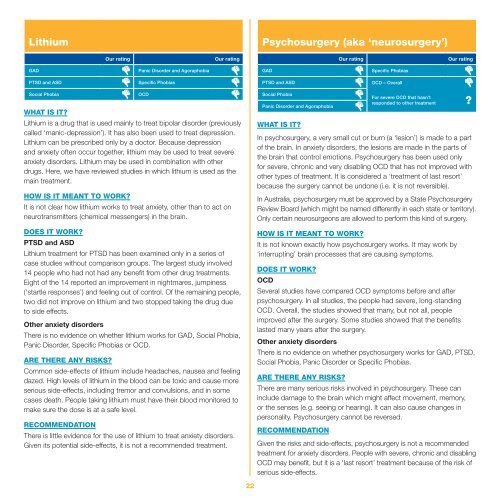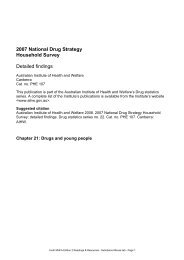A Guide To What Works For Anxiety Disorders - Mental Health First Aid
A Guide To What Works For Anxiety Disorders - Mental Health First Aid
A Guide To What Works For Anxiety Disorders - Mental Health First Aid
Create successful ePaper yourself
Turn your PDF publications into a flip-book with our unique Google optimized e-Paper software.
LithiumPsychosurgery (aka ‘neurosurgery’)Our ratingOur ratingOur ratingOur ratingGADPanic Disorder and AgoraphobiaGADSpecific PhobiasPTSD and ASDSpecific PhobiasPTSD and ASDOCD – OverallSocial PhobiaWHAT IS IT?Lithium is a drug that is used mainly to treat bipolar disorder (previouslycalled ‘manic-depression’). It has also been used to treat depression.Lithium can be prescribed only by a doctor. Because depressionand anxiety often occur together, lithium may be used to treat severeanxiety disorders. Lithium may be used in combination with otherdrugs. Here, we have reviewed studies in which lithium is used as themain treatment.HOW IS IT MEANT TO WORK?It is not clear how lithium works to treat anxiety, other than to act onneurotransmitters (chemical messengers) in the brain.DOES IT WORK?PTSD and ASDLithium treatment for PTSD has been examined only in a series ofcase studies without comparison groups. The largest study involved14 people who had not had any benefit from other drug treatments.Eight of the 14 reported an improvement in nightmares, jumpiness(‘startle responses’) and feeling out of control. Of the remaining people,two did not improve on lithium and two stopped taking the drug dueto side effects.Other anxiety disordersThere is no evidence on whether lithium works for GAD, Social Phobia,Panic Disorder, Specific Phobias or OCD.ARE THERE ANY RISKS?Common side-effects of lithium include headaches, nausea and feelingdazed. High levels of lithium in the blood can be toxic and cause moreserious side-effects, including tremor and convulsions, and in somecases death. People taking lithium must have their blood monitored tomake sure the dose is at a safe level.RECOMMENDATIONThere is little evidence for the use of lithium to treat anxiety disorders.Given its potential side-effects, it is not a recommended treatment.OCDSocial PhobiaPanic Disorder and Agoraphobia<strong>For</strong> severe OCD that hasn’tresponded to other treatment ?WHAT IS IT?In psychosurgery, a very small cut or burn (a ‘lesion’) is made to a partof the brain. In anxiety disorders, the lesions are made in the parts ofthe brain that control emotions. Psychosurgery has been used onlyfor severe, chronic and very disabling OCD that has not improved withother types of treatment. It is considered a ‘treatment of last resort’because the surgery cannot be undone (i.e. it is not reversible).In Australia, psychosurgery must be approved by a State PsychosurgeryReview Board (which might be named differently in each state or territory).Only certain neurosurgeons are allowed to perform this kind of surgery.HOW IS IT MEANT TO WORK?It is not known exactly how psychosurgery works. It may work by‘interrupting’ brain processes that are causing symptoms.DOES IT WORK?OCDSeveral studies have compared OCD symptoms before and afterpsychosurgery. In all studies, the people had severe, long-standingOCD. Overall, the studies showed that many, but not all, peopleimproved after the surgery. Some studies showed that the benefitslasted many years after the surgery.Other anxiety disordersThere is no evidence on whether psychosurgery works for GAD, PTSD,Social Phobia, Panic Disorder or Specific Phobias.ARE THERE ANY RISKS?There are many serious risks involved in psychosurgery. These caninclude damage to the brain which might affect movement, memory,or the senses (e.g. seeing or hearing). It can also cause changes inpersonality. Psychosurgery cannot be reversed.RECOMMENDATIONGiven the risks and side-effects, psychosurgery is not a recommendedtreatment for anxiety disorders. People with severe, chronic and disablingOCD may benefit, but it is a ‘last resort’ treatment because of the risk ofserious side-effects.22




